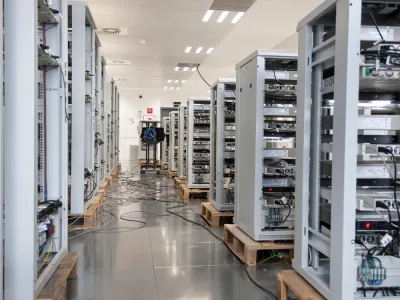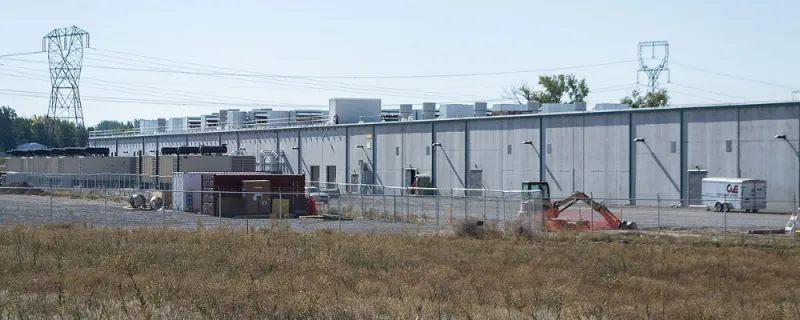Data Centers in MN: CUB’s work to protect ratepayers

This article is the next in a series from CUB discussing the ongoing conversations around data centers and their potential impacts on Minnesota’s residential ratepayers. Find other entries in the series below.
CUB spearheads nation-leading legislation to protect ratepayers from the costs to serve data centers
Legislative Update: Protecting electric ratepayers from the costs to serve data centers
How Xcel's land sale became a $65 million flip for private investors
The growth of the data center industry raises major questions about how to ensure Minnesota’s electric system continues to provide reliable, affordable service while meeting the massive energy needs of these new customers.
In addition to potential environmental impacts, data centers could contribute to higher utility bills for Minnesota customers. Data centers require entire cities’ worth of electricity to operate, with energy consumption in the U.S. already equaling that of 14 million households in 2023. According to some estimates, U.S. data center electricity usage could reach between 400 and 580 terawatt hours by the end of the decade. That’s about 18 to 26 times as much as the cumulative energy usage of every household in Minnesota.
Serving these data centers will be expensive. New generation facilities will need to be built to produce enough electricity to meet energy needs. Transmission lines will need to be constructed to transport energy from where it is generated to where it is needed. Ongoing maintenance and operations costs will increase.
Throughout the country, the impacts of these expenses are starting to find their way onto customers’ bills. The Union of Concerned Scientists found that billions of dollars in data center-related transmission costs are being passed onto other ratepayers. Bloomberg reported that while average wholesale electricity prices have more than doubled since 2020 in some markets, the areas with the biggest increases—with costs up as much as 267%—are located near data center projects. Local opposition is also growing, with residents raisin
g concerns about the environment, energy costs, noise pollution, and the secrecy that often surrounds these projects. Just this week, hundreds of Minnesotans protested zoning changes that would allow a data center to be built in Hermantown.
These stories reinforce worries around the long-term impacts of data centers. Even as some of these projects move forward, CUB is taking steps to ensure everyday Minnesotans are not paying for corporations’ data center projects.

("Amazon Datacenter" by Visitor7 (Own work), [CC-BY-SA-3.0], via Wikimedia Commons)
Minnesota law requires data centers to pay their fair share.
Earlier this year, Minnesota passed a comprehensive package of data center-related policies in the 2025 special session, including nation-leading protections for electricity ratepayers. CUB helped spearhead these efforts and is proud of the work the Legislature put into making sure data centers cover their own costs. We are now taking an active role in ensuring those policies are being carried out. To recap, here are the new regulations and protections found in HF16:
The Minnesota Public Utilities Commission (PUC, the state agency that sets electric and gas rates) is required to define “very large customers” and put them into a separate rate class or sub class. This makes it easier to identify the costs of serving those customers—including data centers—and isolate them from the costs of providing power to homes, businesses, and other industry.
Very large customers must pay for all costs attributable to them. This means that even if data centers require new energy infrastructure, residential ratepayers shouldn’t see any increase to their bills in order to fund those projects. (Though residential ratepayers may still see bill increases for other reasons.)
In addition to covering up-front costs, data centers and other large customers are required to bear the risk that new infrastructure projects may no longer be needed years down the road. The costs of transmission lines and power plants are typically recovered over decades, but it’s difficult to know what data centers’ energy needs will be that far out. If a data center chooses to relocate to another state or reduce its energy demand before that infrastructure is paid down, it could leave a “stranded asset”—an investment that is no longer being used, but on which money is still owed. Minnesota law prohibits utilities from pushing those costs onto other customers.
Dakota Electric Extension of Service Tariff
While the protections in HF16 only apply to customers of investor-owned utilities, that does not prevent cooperative or municipal utilities from adopting similar approaches towards shielding customers. One example was brought forward by the Dakota Electric Association (Dakota Electric), which is an electric cooperative that has chosen to be regulated by the PUC. Dakota Electric recently proposed several changes to its “extension of service” rules to protect its members from the costs of bringing data centers online.
At a high level, Dakota Electric’s proposal requires data centers and other very large customers that need system upgrades to pay for engineering studies and the costs of any infrastructure needed to extend service. While these changes are not meant to be comprehensive, they provide a starting point for making sure data centers are paying their fair share of costs.
CUB provided comments on Dakota Electric’s proposal, advocating for several changes to increase transparency and ensure residential cooperative members are shielded against the expenses of serving new data centers. Once the PUC reviews Dakota Electric’s proposal, it could provide a model that other cooperative and municipal utilities could look to when developing their own protective frameworks.
Xcel’s Rates for "Very Large Customers"
In July, Xcel filed a tariff, or rate proposal, for new “very large customers.” Like other utility rates, this would set the amount that data centers and other large energy users would pay for electricity. The proposal is paired with an electric service agreement (ESA) that spells out additional terms and conditions that data centers must follow to receive electricity. This is the first “very large customer” tariff proposal brought by a utility in Minnesota since the new data center legislation passed earlier this year. As a result, the outcome of this proceeding will likely establish a precedent for other utilities’ data center rates and policies.
While Xcel’s proposal is a step in the right direction, we have some questions about how the tariff would work in practice. We are currently working through the questions outlined below, and have raised our concerns with the PUC.
Minnesota law requires the PUC to define “very large customers” by December 15, 2026. This definition is important, as it’s what the protections discussed above are based on. In its proposal, Xcel suggests that “very large customers” should include any new facilities that require 100 megawatts (MW) or more of electricity. If multiple facilities are owned by the same company, Xcel would add their energy use together to determine if they exceed the 100 MW threshold. To put this into perspective, a general rule of thumb is that a generation facility producing one MW of electricity can power 1,000 homes, although that number can vary based on a variety of factors.
CUB believes the PUC should open an industry-wide docket to define “very large customers.” Otherwise, Xcel’s proposed definition could set a precedent without other utilities and stakeholders having input. While this could delay Xcel’s tariff proceeding slightly, it would allow for consistency in how these customers are identified and treated.
We’re also unsure whether the 100 MW threshold is appropriate. There are multiple different thresholds—primarily ranging from 25 MW to 100 MW—that have been used for similar tariffs in other states. If the threshold is set too high, it might not capture all customers that require substantial infrastructure investments prior to receiving electricity service. For example, a customer could fall just short of 100 MW but still require expensive upgrades before being added to the grid. Situations like these could be reviewed in an industry-wide proceeding to make sure the definition fully captures customers that could impose significant costs on other ratepayers.
Xcel proposes to use an “incremental cost test” to identify the revenues and expenses associated with connecting data centers to the grid and serving them over time. This includes things like energy and demand charges, fuel costs, certain transmission expenses, and the need for new generation or energy storage resources. How these estimates are calculated—and whether the test itself actually captures all expenses attributable to very large customers—is a primary focus of stakeholders in the regulatory proceeding. Some parties, including the Office of the Attorney General, have raised concerns about the adequacy of this test.
Xcel proposes that data centers and other very large customers be required to receive electric service for a minimum of 15 years. Many of the infrastructure investments necessary to serve these customers are recovered over a much longer period. Typically, the costs of generation and transmission projects are recovered from customers over a period of decades. If a very large customer is allowed to leave after only 15 years, then other ratepayers could be left to foot the bill long after data centers leave town – which is why the “stranded asset” provisions of HF16 were passed.
CUB believes that additional protections are needed to ensure data centers pay for the infrastructure needed to serve them. Some of our ideas include:
- Having longer minimum terms for electricity service;
- Imposing fees if a data center leaves a utility’s service territory or reduces its electricity demand after the initial term;
- Accelerating recovery so the very large customer pays down all infrastructure costs during the first 15 years of receiving service.
Another option would be to allow very large customers to build their own generation facilities that comply with Minnesota’s carbon free electricity law. This would aid the state in meeting its energy goals while ensuring none of the generation costs are passed onto other customers.
A major portion of utilities’ rates are based on the cost of serving different customer classes. That’s why the electricity rates for residential households are different from the rates for local businesses and large industry. How those expenses are divided up, or “allocated,” is a complicated process that requires experts to testify in utility rate cases.
If a new data center comes online between rate cases, they might not be represented in those calculations. This raises questions about how to make sure very large customers pay their fair share as soon as they start receiving service. CUB is still evaluating potential options to make sure residential households are not paying for these extra costs.
What’s next for data centers in Minnesota?
Many different stakeholders are currently evaluating Xcel’s rate proposal for new data centers and very large customers. These include ratepayer advocates, environmental nonprofits, clean energy groups, state agencies, data center companies, and organized labor. The perspectives of all of these parties will be included in the record, and the PUC will make a decision based on that evidence.
Comments on Xcel’s rate proposal can be submitted through December 5. If you want to make your voice heard, you can share your perspective with the PUC by filing a public comment referencing Docket No. 25-289. Please know that everything you include in your comment, including your name, email address, and any identifying information, will become part of the public record.
CUB will continue to advocate for the changes necessary to protect Minnesotans from data center costs. Keep an eye on our newsletter and social media to receive updates about this proceeding and other energy news.